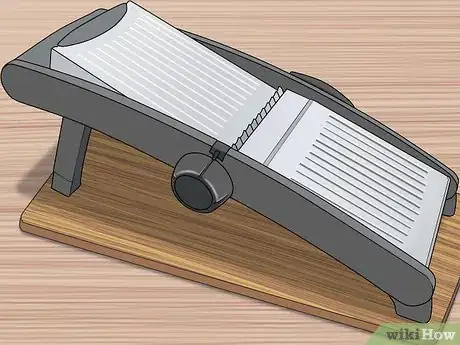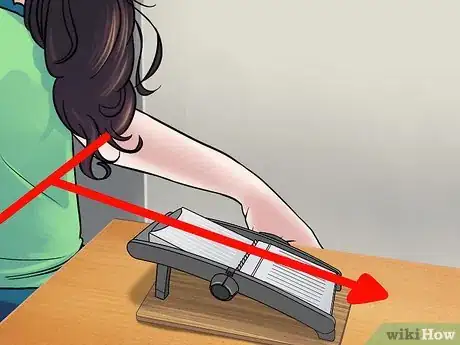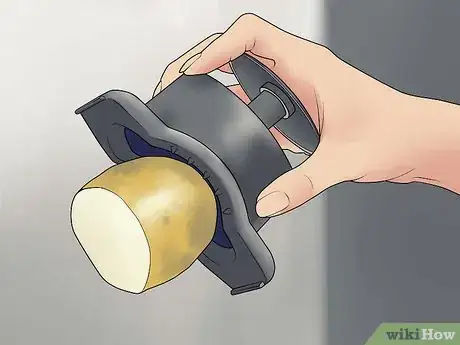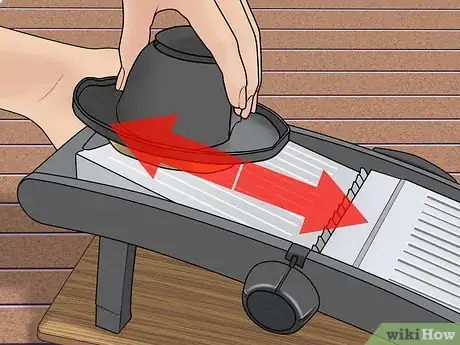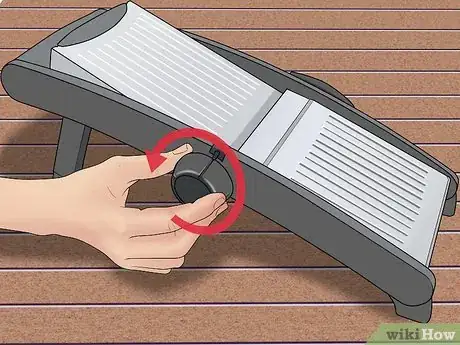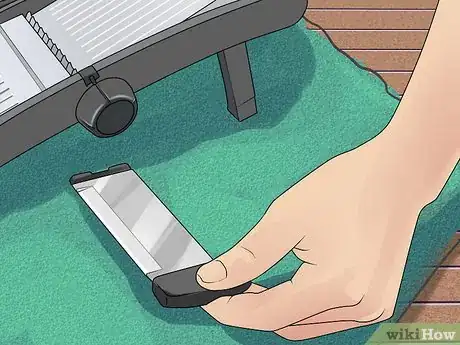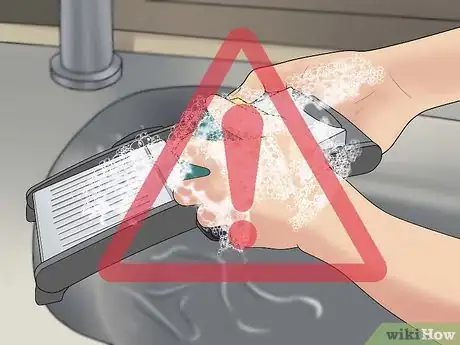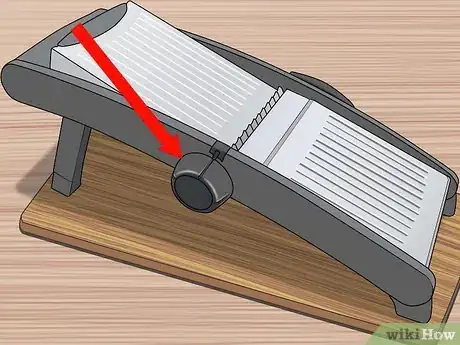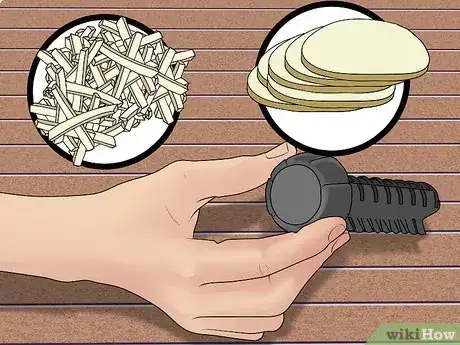This article was co-authored by Andrea Lawson Gray. Andrea Lawson Gray is a Private Chef and the Co-Founder of Private Chefs of the SF Bay. With more than ten years of experience, she specializes in Mexican cuisine and culinary history. Chef Andrea is also the author of Celebraciones Mexicanas: History, Traditions, and Recipes, an award-winning cookbook.
There are 7 references cited in this article, which can be found at the bottom of the page.
This article has been viewed 111,165 times.
Mandolines slice fruits and vegetables into beautiful, even slices. While you can use them for salad ingredients, they are especially useful for delicate cooking operations. For example, the consistent size of Mandoline-cut French fries ensures that they all crisp at the same rate. You may also achieve thinner cuts than you could with a knife, which is an excellent technique for gratin or shaved garnishes. Whatever food you're slicing, read on to find out how to operate this cutting tool safely and effectively.
Things You Should Know
- Always keep the raised end of the mandoline close to you to avoid injury.
- Make sure to stick the hand guard to the food you're cutting so you don't accidentally cut your fingers.
- Switch out the blade of your mandoline to change the thickness or style of cut.
Steps
Basic Use
-
1Prop the mandoline on a cutting board. Fold out the mandoline's legs and place them on a sturdy, dry cutting board. The mandoline should never wobble or slip during use.
- Make sure the cutting board is clean, as it will come into contact with the chopped food.
-
2Face the mandoline perpendicular to you. Keep the raised end closest to you. Pushing down and forward gives you the most control. Do not set the mandoline parallel to you, as a side-to-side slice can cause slipping or uneven results.[1]Advertisement
-
3Cut the food to make a flat surface. If you're cutting a potato, lemon, or other round fruit or vegetable, cut it in half. The mandoline can only slice a flat surface. Keep the other end round to give you a better grip.[2]
- You may need to cut it into smaller pieces to fit inside the hand guard.
-
4Wet the runway (optional). If you're cutting potatoes or another dry, starchy food, sprinkle a few drops of water across the cutting surface. This ensures that the food will slide across it smoothly.
- Juicy fruits and vegetables usually produce enough moisture on their own.
-
5Place the food inside the hand guard. Almost all mandolines come with a hand guard, usually shaped like a bell or cylinder. Place the food in the hand guard so the flat side faces the runway, then slot the hand guard over the mandoline.[3] Mandoline blades can easily slice off the tip of your finger. Only professionals should use a mandoline without the hand guard (and they have the scars to prove it).
- A cut-resistant glove can provide additional protection. See Tips below for more information.[4]
-
6Hold the mandoline steady with one hand. Use your non-dominant hand to hold the nearest leg of the mandoline.
-
7Push the food down the runway. Grip the food with the hand guard.[5] Push it down the runway, and the blades will cut one slice. Repeat this motion with even pressure to keep all slices the same thickness.
- Mandolines with one horizontal blade may require a slow, sawing motion for soft foods like tomatoes.[6] This shouldn't be a problem with V-shaped blades.
Cleaning and Storing
-
1Adjust all blades for maximum safety. If you used an extra blade feature (such as for julienning), return it to its original hidden position. If your main blade is adjustable, set it to its lowest position.
-
2Wipe the blade with a wet, soapy cloth. Wipe slowly from the base of the blade to the tip, to reduce the chance of cutting yourself. Once any food scraps or stains are gone, rinse off the soap under running water.
-
3Dry thoroughly. Put it on the rack to air dry, or dry it carefully with a towel. Storing the mandoline while wet can lead to rust.
-
4Store away from children and pets. Mandolines are significantly more dangerous than knives. Never leave them somewhere a child could reach.
- Ideally, keep your mandoline in a labeled container. Never place it loose in a drawer or on a high shelf where someone might put their hand without looking.
-
5Give it a thorough clean when necessary. An occasional deep clean is a good idea if you use your mandoline often. Most plastic mandolines and some stainless steel mandolines can be run through the dishwasher, but hand washing is gentler on the blades. When washing by hand, handle with caution and consider wearing cut-resistant gloves.
Adjusting Settings
-
1Look for a knob. If your mandoline has a knob on the side, it's easy to adjust. Just turn the knob to raise or lower the blade, and the mandoline will slice to a different thickness. Most mandolines can cut anything from French fries to paper-thin gratins and garnishes.
- The knob usually has a thickness label. This isn't perfect, since the amount of pressure you use affects thickness, but it doesn't need to be perfect for most recipes.
- Some models use a lever instead, but be careful — the lever could enable other features instead, as described below.
-
2Switch to a different blade instead. Some models come with several different blade attachments instead of an adjustment knob. To change slice thickness or switch to a special cut (julienne, crinkle, or waffle), you'll need to swap in a new blade. This can be quite dangerous. We strongly recommend you check your owner's manual, since every model has its own safety and handling instructions.
- Some mandoline blades are accessible from the underside. Others have a hinge that swings open to reveal the blade underside. You then pop out the blade from its base and insert the new blade into its slot.
- Some models have one fixed blade, and multiple plastic runway attachments. These are much easier to switch in and out.
-
3Check for extra features. The most common of these is an extra blade to julienne the food into thin strips, crinkle cut it, or perform another specialty cut. This may be built-in and raised by a lever on the underside of the device. If separate from the body of the mandoline, you typically hold it by the handle and insert it into the mandoline from the side.
- Be very careful when looking for this lever. On some models you can cut yourself on the underside of the blade.
- Julienning is often difficult on a mandoline, especially with hard vegetables. Some chefs prefer to slice the ingredient as usual, then julienne the slices by hand.
References
- ↑ http://www.finecooking.com/videos/how-to-use-mandoline.aspx
- ↑ http://simmerandboil.cookinglight.com/2013/03/07/why-you-need-mandoline/
- ↑ Andrea Lawson Gray. Private Chef. Expert Interview. 10 February 2022.
- ↑ Andrea Lawson Gray. Private Chef. Expert Interview. 10 February 2022.
- ↑ Andrea Lawson Gray. Private Chef. Expert Interview. 10 February 2022.
- ↑ http://www.finecooking.com/videos/how-to-use-mandoline.aspx
- ↑ http://www.cooksillustrated.com/equipment_reviews/1148-cut-resistant-glove
- ↑ http://www.webstaurantstore.com/guide/607/types-of-cut-resistant-gloves.html
- ↑ http://thesweethome.com/reviews/best-mandoline/
Expert Q&A
-
QuestionHow do you use an adjustable mandoline slicer?
 Andrea Lawson GrayAndrea Lawson Gray is a Private Chef and the Co-Founder of Private Chefs of the SF Bay. With more than ten years of experience, she specializes in Mexican cuisine and culinary history. Chef Andrea is also the author of Celebraciones Mexicanas: History, Traditions, and Recipes, an award-winning cookbook.
Andrea Lawson GrayAndrea Lawson Gray is a Private Chef and the Co-Founder of Private Chefs of the SF Bay. With more than ten years of experience, she specializes in Mexican cuisine and culinary history. Chef Andrea is also the author of Celebraciones Mexicanas: History, Traditions, and Recipes, an award-winning cookbook.
Private Chef There's not really a secret here. Most mandolins can be adjusted to control the thickness of the slices. All you gotta do is turn it over and look for the adjustment mechanism.
There's not really a secret here. Most mandolins can be adjusted to control the thickness of the slices. All you gotta do is turn it over and look for the adjustment mechanism. -
QuestionHow much does a mandoline cost?
 Community AnswerMandoline slicers can cost around $15 and up, depending on the brand and features you are looking for.
Community AnswerMandoline slicers can cost around $15 and up, depending on the brand and features you are looking for.
Warnings
- Old-fashioned French-style mandolines with just one horizontal blade are particularly dangerous.[9]⧼thumbs_response⧽
- Professional chefs tend to recommend mandolines that are compact, sturdy, and sharp. This doesn't always line up with a home user's needs, which should focus more on safety and ease of use.[10]⧼thumbs_response⧽
About This Article
To use a mandoline, unfold the mandoline's legs, place them on a cutting board, and face the mandoline perpendicular to you. Next, cut the fruit or veggie in half to create a flat surface. Then, place the food in the hand guard so the flat side faces the runway and slot the hand guard over the mandoline. Finally, hold the mandoline steady with your non-dominant hand and push the food down the runway to cut one slice. Repeat this motion with even pressure to make more slices of the same thickness. For tips on adjusting the settings, read on!
